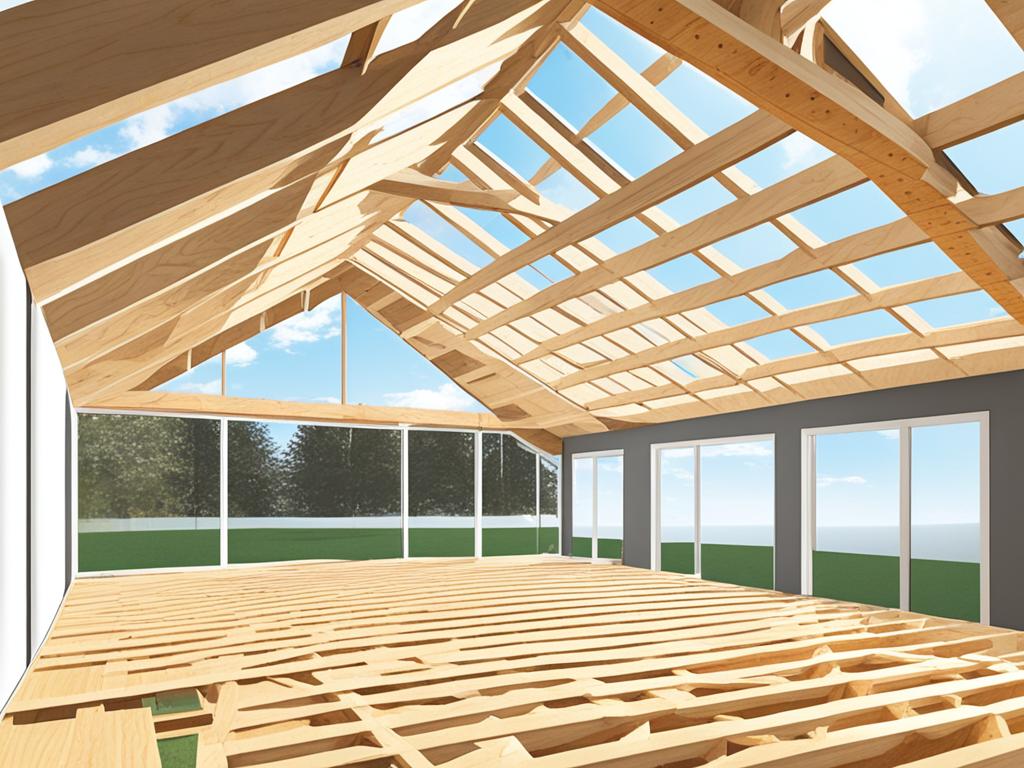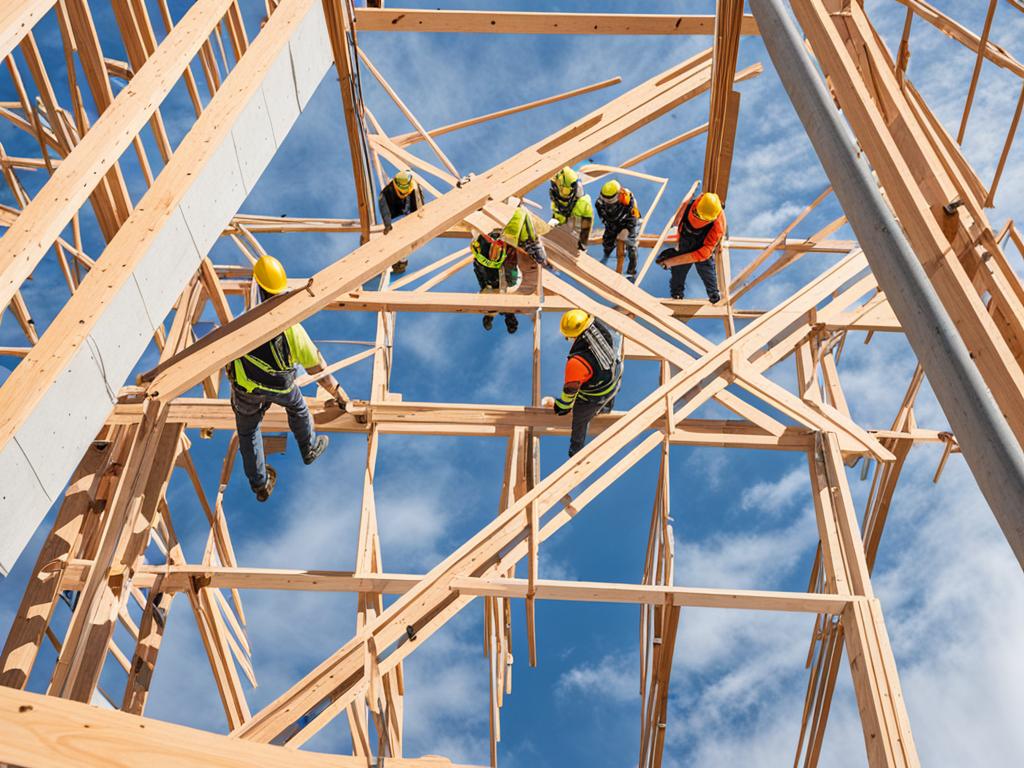When it comes to roof construction, choosing between rafters and trusses can have a significant impact on your budget. Both options have their advantages and considerations, but understanding the cost differences can help you make an informed decision.
Rafters, commonly used in traditional stick-framed architecture, are custom-cut wooden beams that support the roof deck and other roofing materials. On the other hand, trusses are pre-fabricated webbed units that are delivered to the construction site.
So, which option is cheaper? Generally, trusses tend to be more budget-friendly compared to rafters. This is mainly due to lower labor and material costs associated with truss production. Trusses are made in a factory, which streamlines the process and reduces the need for on-site construction time.
While rafters can be more expensive, they offer certain advantages. Rafters provide more flexibility for future attic conversions, allowing you to make the most of your space. Additionally, some homeowners prefer the traditional appeal of rafters.
Key Takeaways:
- Trusses are more cost-effective than rafters due to lower labor and material costs.
- Rafters offer more flexibility for future attic conversions.
- Rafters tend to be more expensive than trusses.
- Trusses require less building time and are ready to install once delivered.
- The number of contractors skilled in building rafters is declining, making trusses more popular.
What are Rafters?
Rafters are an essential element of traditional stick-framed roof architecture. These wooden beams play a crucial role in supporting the roof deck and other roofing materials, providing structural integrity to the entire roofing system. Unlike trusses, which are pre-fabricated units, rafters are custom-cut on-site during construction, allowing for more flexibility in roof design.
The roof rafter dimensions will depend on various factors such as the span of the roof, the pitch angle, and the load-bearing requirements. Rafter pros include the ability to provide more space for attic conversions in the future, making them a popular choice for homeowners looking to expand their living space. In addition, rafters are remote-location friendly, as they can be constructed on-site without the need for pre-planning or transportation of pre-made units.
Rafters offer several advantages for homeowners, including the ease of insulation and the simplicity of future conversions. They also provide a traditional aesthetic appeal that many homeowners appreciate.
However, while rafters have their benefits, they also come with some cons. One of the main disadvantages is the higher cost compared to trusses. Rafters require more labor and time for on-site construction, which can result in increased project costs. Additionally, the weather can pose a risk during the construction process, potentially leading to delays.
Moreover, the installation of rafters requires specialized skills and expertise, as they are custom-cut and need to be properly secured to the exterior walls using ceiling joists. It is crucial to work with experienced professionals to ensure the correct installation and structural stability of the roof.

In the next section, we will explore the world of trusses and compare them to rafters to help you make an informed decision for your roof construction project.
Rafter Pros:
- Remote-location friendly
- No pre-planning required
- Easier to insulate
- Allows for simple conversions
Rafter Cons:
- Higher cost
- Longer building time
- Weather risk during construction
- Requires specialists for installation
| Rafter Pros | Rafter Cons |
|---|---|
| Remote-location friendly | Higher cost |
| No pre-planning required | Longer building time |
| Easier to insulate | Weather risk during construction |
| Allows for simple conversions | Requires specialists for installation |
What are Trusses?
Trusses are pre-fabricated webbed units used in roof construction. Unlike traditional rafters, trusses are manufactured in a factory and delivered to the construction site. They are composed of top chords, bottom chords, and web bracing, which provide structural support and stability.
Trusses can be made from various materials including wood, steel, or a combination of both. Their design allows them to offer superior strength and load-bearing capabilities, making them capable of supporting heavier roof materials compared to rafters.
One of the main advantages of choosing trusses over rafters is their cost-effectiveness. Trusses require less labor and material, resulting in lower overall costs for roof construction projects. Additionally, trusses are DIY-friendly and can be easily installed once delivered to the site, allowing for faster framing and construction.
However, it’s important to consider some potential drawbacks of using trusses. Due to their pre-fabricated nature, trusses tend to be larger and heavier than traditional rafters. This can make transportation to remote locations more challenging. Furthermore, trusses offer limited design options compared to rafters, which can be custom-cut on-site to accommodate specific architectural requirements.
Overall, trusses provide a cost-effective and efficient solution for roof construction, particularly for projects with standard designs and non-remote locations. Their strength and ease of installation make them a popular choice among contractors and homeowners alike.
| Truss Components | Advantages | Disadvantages |
|---|---|---|
| Top chords | – Increased load-bearing capacity – Consistent structural performance |
– Limited design flexibility |
| Bottom chords | – Enhanced stability – Easy installation |
– Larger and heavier |
| Web bracing | – Additional support and rigidity – Cost-effective construction |
– Difficult transportation to remote locations |
Note: The table above provides an overview of the components, advantages, and disadvantages of trusses in roof construction.

Conclusion
When it comes to choosing between rafters and trusses for your roof construction, there are several factors to consider. Rafters, being part of the traditional stick-framed architecture, offer more flexibility for future attic conversions. However, they tend to be more expensive and require longer building time, especially for larger homes. On the other hand, trusses are pre-fabricated units that provide strength and cost-effectiveness. They are ready to install, require less building time, and have become increasingly popular.
While rafters allow for easy custom cutting on-site and can provide more space for future conversions, trusses offer a quicker framing process and are more suitable for supporting heavier roof materials. Trusses’ factory-made construction makes them DIY-friendly and lowers labor and material costs. However, it is important to note that trusses may have limited design options compared to rafters.
In conclusion, the choice between rafters and trusses ultimately depends on your specific needs, budget, and timeline. If you prioritize future flexibility and are willing to invest more time and money, rafters might be the better option. However, if cost-effectiveness, strength, and faster construction are key considerations, trusses would be a suitable choice. Consulting with a professional contractor and considering the unique requirements of your project are essential steps to making an informed decision.
FAQ
How do the costs of rafters and trusses compare?
Which is cheaper, rafters or trusses?
What is the difference in cost between rafters and trusses?
How much does it cost to install rafters versus trusses?
What factors should I consider when comparing the cost of rafters and trusses?
Are rafters more expensive to build compared to trusses?
How much longer does it take to build rafters on-site compared to installing trusses?
Are trusses becoming more popular compared to rafters?
What are the advantages of choosing rafters?
What are the advantages of choosing trusses?
What are the disadvantages of choosing rafters?
What are the disadvantages of choosing trusses?
Source Links
- https://colonyroofers.com/learningcenter/rafters-trusses-pros-cons
- https://www.angi.com/articles/rafters-vs-trusses.htm
- https://todayshomeowner.com/roofing/guides/rafters-vs-trusses/
